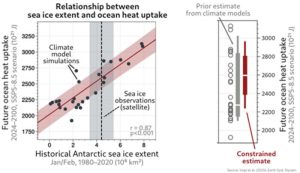The groundbreaking study provided a significant and previously underestimated relationship between Antarctica sea ice, cloud cover and global warming.
This study shows that the current Antarctic sea ice range is larger than predicted by climate models, suggesting that more significant global warming can be expected in the coming decades.
The study, led by Linus Vogt of the Sorbonne University, exploited emergency constraints based on data from 28 Earth System models and satellite observations from 1980 to 2020.
This constraint allowed the team to reduce uncertainty in climate predictions and provide more accurate estimates of key climate variables.
Sea level rise could be up to 14% higher than previously predicted
The results of this study show that by 2100, marine heat uptake and the resulting Atami level rise are projected to be 3-14% higher than the average for CMIP6, the main collection of climate models.
Furthermore, predicted cloud feedback is estimated to be 19-31% stronger, increasing climate sensitivity, and global surface warming is estimated to be 3-7% greater than previously thought.
The role of Antarctic Ocean Ice in nearby climate change
This study found that the degree of Antarctica’s summer sea ice is thought to be stable and vulnerable to human-induced climate change, and is an important indicator of the southern hemisphere climate.
The model begins with a higher, more accurate representation of pre-industrial sea ice levels simulates colder surface waters, cold deep sea temperatures, and dense cloud covers in mid-latitudes.

These initial conditions amplify the warming reaction under forced greenhouse gases. This leads to more severe and accelerated warming effects than previously estimated.
“When we first discovered this link between historic Antarctic sea ice and future global ocean heat uptake, we were amazed at the strength of the relationship. Since Antarctic sea ice is less than 4% of the sea level, how can it be strongly linked to global ocean warming?” said Linus Vogt, who led the study.
“After many analyses, we understand the full implications of the sea ice and atmosphere coupling that is responsible for these global changes.”
The role of clouds in accurate climate predictions
The higher the sea ice area, the stronger the cloud cover. This gives an overall cooling effect by reducing the amount of incoming solar radiation.
Therefore, greater sea ice losses over the next few decades will result in significant cloud reductions, stronger surface warming, and increased absorption of marine heat.
As a result, the model’s sea ice baseline state and deep sea temperature effectively assume future warming, cloud feedback, and heat magnitude.
Jens Tellhaal, a senior scientist in the Department of Climate and Environmental Physics at the University of Bern, explains: “While it has long been known that accurate cloud representation is important for climate prediction, our study accurately simulates surface-to-deep sea circulation and emphasizes that interactions with southern sea ice are equally important.”
Policy and Science Impact
This new study provides evidence that current models may underestimate future warming and marine heat storage. These models tend to simulate the South that is too warm in pre-industrial conditions, and there is too little chance of warming.
It also highlights the importance of ongoing satellite monitoring and enhanced modeling of cloud processes and deep-sea hydrography, both of which have a major impact on global climate forecasts.
VOGT concluded: “Several well-known studies have used temperature trends over the last few decades to constrain future warming, but we have found that this approach can have misleading consequences.
“Accounting of sea ice-related mechanisms we have identified will lead to increased estimates of future ocean and atmospheric warming, which may require urgent action to reduce greenhouse gas emissions to avoid increased heatwaves, floods and ecosystem impacts associated with ocean warming.”
Source link

